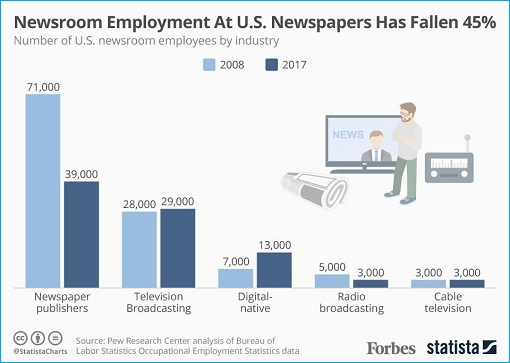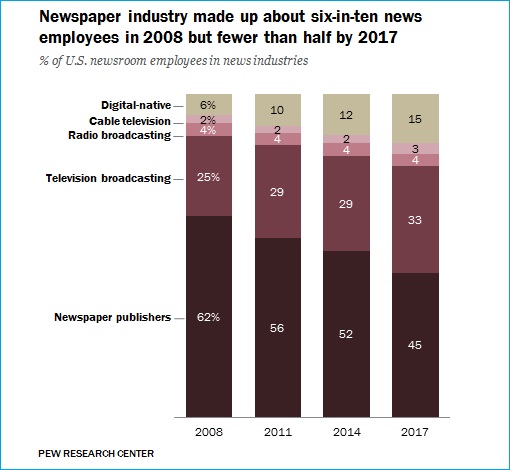If your kids tell you that they wanted to work for a newspaper company, you should start worrying. The past decade has been a painful period for employees in U.S. newsroom, especially those working for newspaper. The only area that has experienced some growth in employment is digital-native news sector.
According to a Pew Research Center analysis of Bureau of Labour Statistics Occupational Employment Statistics survey data, the number of U.S. newsroom employees fell from approximately 114,000 in 2008 to 88,000 by 2017 – a drop of 23%. Those employees included reporters, editors, photographers and videographers.
Job losses at newspapers newsroom were the worst, having dropped 45% – from about 71,000 workers in 2008 to 39,000 in 2017. The newsroom employment involved 5 industries that produce news – newspaper, radio, broadcast television, cable and “other information services” (digital-native news publishers).

Unlike their counterparts working for newspaper companies, the number of digital-native newsroom employees increased by 79% – from about 7,400 workers in 2008 to about 13,000 in 2017. Unfortunately, the increase of about 6,000 total jobs in digital segment was not sufficient to offset the loss of about 32,000 newspaper jobs during the same period.
Employment in broadcast television was relatively stable, remaining at about 28,000 between 2008 and 2017. Jobs in cable television were also stable, at about 3,000 over the same period. Radio broadcasting, on the other hand, lost about 27% of its newsroom employees, dropping from about 4,600 workers in 2008 to about 3,300 in 2017.
Essentially, the newsroom employment saw how 6 in 10 (62%) of all news employees working for newspapers in 2008 would end up with less than 45% by 2017. On the contrary, the proportion for digital-native news employees increased, approximately doubling over the period, from 6% of all newsroom employees in 2008 to 15% in 2017.

U.S. newspapers have been hit by waves of layoffs over the past decade amid steep falls in circulation and advertising. Last week alone, the New York Daily News, the century-old tabloid known for its provocative headlines, announced it was slashing half its editorial staff. The move came little over a year after Tronc, the parent company of the Chicago Tribune, bought the tabloid for US$1.
Likewise, Warren Buffett’s Berkshire Hathaway Inc. had also slimmed down its newspaper empire when BH Media Group reduced its staff by 148 employees and not filling 101 vacant positions back in Feb 2018. Buffett’s hometown newspaper, the Omaha World-Herald, eliminated 43 positions while the Press of Atlantic City cut 16 jobs.
In reality, newspapers have been dying in slow motion for two decades now. In the U.S., weekday print circulation has shrunk from a high of nearly 60 million in 1994 to 35 million for combined print and digital circulation today – 24 years of decline. Advertising revenue has gone south, falling from US$65 billion in 2000 to less than US$19 billion in 2016.

The Washington Post and The New York Times are two most successful U.S. newspapers at earning revenue through digital subscription model. Yet, even both mainstream media struggle as digital subscription and advertising revenue has not made up for the collapse of print advertising industry-wide. American newspapers, however, didn’t suffer alone.
Canadian newspapers have lost three-quarters of a billion dollars per year of reliable classified advertising revenue to eBay and Craigslist. Britain has nearly 200 fewer regional and local newspapers now than in 2005. In fact, things have gotten so bad that British Prime Minister Theresa May has warned that the closure of newspaper after newspaper is a “danger to democracy.”
Other Articles That May Interest You …
- Top-15 Chief Executives Who Will Be Jobless For Playing Politics – Some Were Paid RM300,000 / Month
- After Microsoft, Now Hewlett Packard Plans To Cut 5,000 Jobs – By Christmas – Worldwide
- This EU Country Is So Screwed Up That 85,000 People Applied For 30 Jobs
- Here’re 25 Highest Paying Jobs Currently On Offer In America For 2016
- How To Boost Your Chance By “19 Times” For A Job Interview – Wear Low-Cut
- 50,000 Global Jobs Cut So That HSBC Can Reward Shareholders
- Wanna Work At McDonald’s? Here’re 20 Job Interview Questions & Answers

|
|
July 31st, 2018 by financetwitter
|


|

|

|

|

|

|




























Comments
Add your comment now.
Leave a Reply